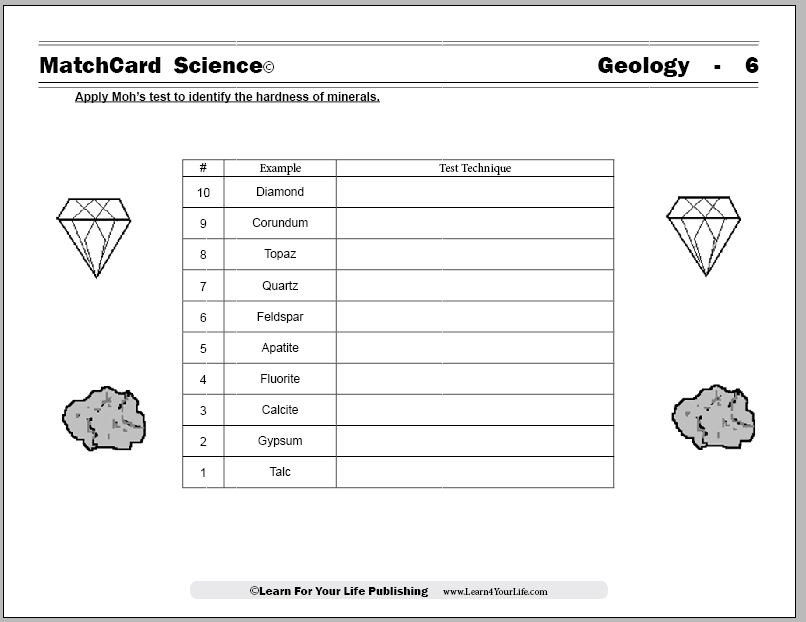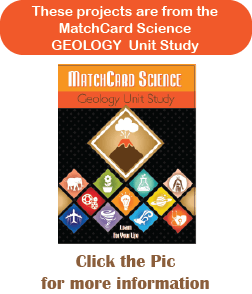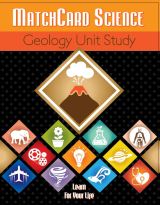Mohs Hardness Test
Let's Have Some Moh Fun
Kids have fun analyzing minerals with the Mohs hardness test.
Worksheet and suggested activities below
Free Download Below


Mohs Hardness MatchCard
Objective: Apply Moh's hardness test to identify the hardness of minerals.MatchCard: Download below.
MatchCard Information Pieces describe the different steps of Mohs Test. Ideas for projects are listed on the instructor's page and below.
Print Mohs Hardness MatchCard
This is MatchCard #5 of the Geology Unit Study. Look below for more information on MatchCards and the MatchCard Science curriculum.How Moh's Hardness Test Works
Moh's Hardness is a scale from 1 to 10 listing minerals from the softest (1) to the hardest (10).A rock or mineral can only be scratched by an object with a higher ranking on the scale. Therefore, if you know what a mineral is, you can use it to help identify the hardness of other minerals. That will help identify the mineral itself.
There are also other common items such as glass, steel, copper, and even fingernails, that can be used in place of other minerals to identify the hardness of a particular rock or mineral.
Using A Moh's Kit
Mohs Hardness Activity #1
You can either buy a Moh's Kit like the one above, or make one buy acquiring ten specimens of common minerals.
The most commonly used minerals are:
- 10. Diamond
- 9. Corundum
- 8. Topaz
- 7. Quartz
- 6. Feldspar
- 5. Apatite
- 4. Fluorite
- 3. Calcite
- 2. Gypsum
- 1. Talc
To perform the test, give the students the minerals without any identification. They must see what minerals will scratch the other minerals.
By trial and error, the students arrange the specimens in order of hardest to softest.
Identify Unknown Specimens
Mohs Test Activity #2
After students have performed the first test, they can now use the known minerals to identify the hardness of unknown minerals.
Give the students 5 to 6 specimens of other rocks and minerals. Let them experiment to identify the hardness on the Mohs Scale.
Once the hardness is identified, let them use a rock guide to see if they can find the name of their specimen.
If a rock is being tested, once it is found in the field guide the student should also identify if it is a Igenous, Sedimentary, or Metamorphic rock.
Use Common Tools
Test #3
For this final rock identification activity, we will use common tools instead of known specimens.
- Fingernail
- Copper penny
- Nail
- Steel knife (does not need to be sharp)
- Steel file
- Glass (pocket sized mirror will work)
With the assortment of specimens, they start at the bottom test of hardness (fingernail), and if it does scratch the surface of the rock, they move to the next hardest test.
- 10. The hardest mineral
- 9. Can only be scratched by a diamond
- 8. Rock can scratch glass
- 7. Rock can scratch steel
- 6. Scratched by a steel file
- 5. Scratched by a steel knife
- 4. Scratched by a nail
- 3. Scratched by a copper penny
- 2. Scratched by a fingernail
- 1. Easily scratched by a fingernail
MatchCard Science
How To Use MatchCards

Download the FREE MatchCard Science Instructor's Guide and see how MatchCards can make building their science knowledge base fun.
Geology Unit Study

12 Science Unit Studies

Chemistry is only one of twelve complete unit studies for kids in 3rd to 8th grade.
Comprehensive objectives, hands-on projects, suggested science fair experiments, and the fun game-like MatchCards keep them interested in learning science. See all twelve MatchCard Science Unit Studies.
About Our Site
Hands-On Learning














